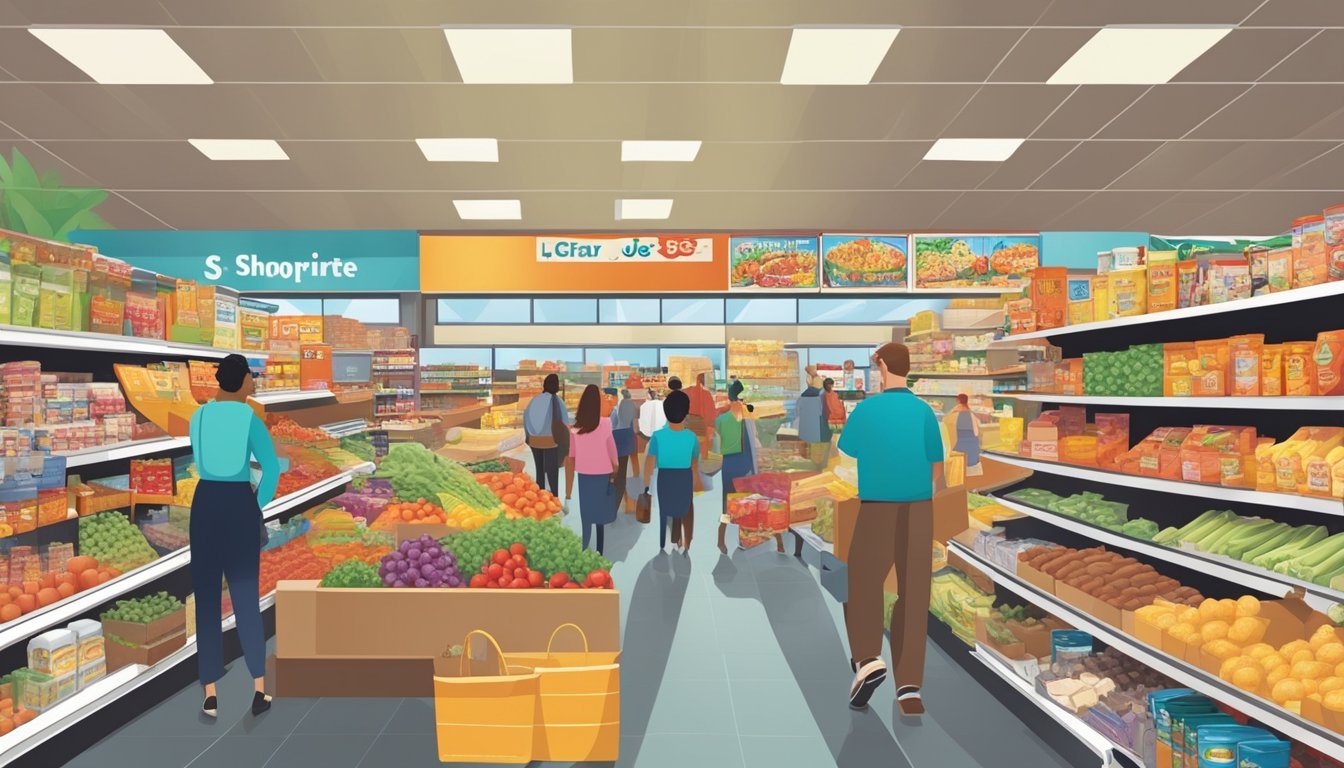Shoprite vs Trader Joe's
A Comprehensive Comparison of Price, Quality, and Selection
ShopRite and Trader Joe's are two popular grocery store chains that cater to different customer needs and preferences. While ShopRite is known for its wide selection of products and competitive prices, Trader Joe's has built a reputation for unique, high-quality items and a curated shopping experience.
When comparing prices, Trader Joe's generally offers lower costs on many items, with produce prices about 5% less than ShopRite and meat prices approximately 6% lower. This pricing advantage extends to other product categories as well, making Trader Joe's an attractive option for budget-conscious shoppers.
Beyond price considerations, the choice between these two stores often comes down to individual preferences. ShopRite provides a more traditional supermarket experience with a broader range of brands and products. Trader Joe's, on the other hand, focuses on its own private label offerings and specialty items, appealing to those seeking unique flavors and organic options.
Overview of Shoprite and Trader Joe's
ShopRite and Trader Joe's are two distinct grocery store chains that cater to different market segments. They offer unique shopping experiences, product selections, and pricing strategies.
Company Histories
ShopRite's roots trace back to 1946 when a group of independent grocers formed Wakefern Food Corporation. This cooperative structure allowed small retailers to compete with larger chains. ShopRite stores are independently owned and operated while benefiting from the buying power of Wakefern.
Trader Joe's began as a convenience store called Pronto Markets in 1958. Joe Coulombe transformed the concept into Trader Joe's in 1967, focusing on unique, value-priced products. The company was acquired by Aldi Nord in 1979 but maintains its distinct identity and operations.
Market Presence and Locations
ShopRite has a strong presence in the Northeastern United States. The chain operates over 300 stores across New Jersey, New York, Connecticut, Delaware, Pennsylvania, and Maryland. Its stores vary in size and format, from smaller urban locations to large supermarkets.
Trader Joe's has expanded nationally, with over 500 stores in 42 states and Washington D.C. Their stores are typically smaller than traditional supermarkets, averaging around 10,000-15,000 square feet. This compact format allows Trader Joe's to establish locations in urban areas and smaller communities.
Brand Philosophy and Image
ShopRite positions itself as a full-service supermarket offering competitive prices and a wide selection of products. The chain emphasizes its ability to cater to diverse customer needs, from budget-conscious shoppers to those seeking specialty items. ShopRite stores often feature in-store pharmacies, large produce sections, and extensive deli counters.
Trader Joe's cultivates a unique, laid-back atmosphere with a focus on curated, often private-label products. The company is known for its friendly staff, often dressed in Hawaiian shirts, and its emphasis on natural and organic offerings. Trader Joe's limits its product selection to around 4,000 items, compared to the 50,000+ found in typical supermarkets, allowing for efficient operations and lower prices.
Comparing Shopping Experience
The shopping experience at ShopRite and Trader Joe's differs significantly in several key areas. These include store layout, product availability, customer service, and overall store maintenance.
Store Layout and Design
ShopRite stores typically feature a traditional supermarket layout with wide aisles and clear department signage. The larger format allows for a more spacious feel, making it easier to navigate with shopping carts.
Trader Joe's, in contrast, opts for a compact, intimate design. Stores are usually smaller, with a more whimsical decor featuring hand-painted signs and themed displays. This creates a unique, almost boutique-like atmosphere.
The smaller footprint of Trader Joe's can sometimes lead to crowded aisles during peak hours. ShopRite's larger spaces generally avoid this issue, providing a more relaxed shopping environment.
Product Placement and Availability
ShopRite excels in product variety, offering a wide range of brands and options for each item. Shoppers can find everything from budget-friendly store brands to premium national labels.
Trader Joe's takes a different approach, focusing on a curated selection of mostly private-label products. This results in fewer choices per item but often leads to unique, high-quality offerings not found elsewhere.
Product placement at ShopRite follows a logical, category-based arrangement. Trader Joe's, however, often groups complementary items together, encouraging shoppers to try new combinations.
Customer Service and Support
Both stores prioritize customer service, but with different approaches. ShopRite tends to have more staff available throughout the store, making it easier to find assistance when needed.
Trader Joe's is known for its friendly, knowledgeable crew members who often engage customers in conversation. They're quick to offer product recommendations and cooking tips.
At checkout, ShopRite typically offers both staffed lanes and self-checkout options. Trader Joe's usually sticks to traditional checkout lanes, fostering more personal interactions with cashiers.
Cleanliness and Maintenance
ShopRite maintains a clean, well-lit environment typical of large supermarkets. Regular cleaning schedules ensure floors are swept and spills are promptly addressed.
Trader Joe's also prioritizes cleanliness, with the added touch of frequently restocking and reorganizing shelves throughout the day. This constant attention helps maintain a tidy appearance despite the smaller store size.
Both chains generally receive positive feedback for their sanitation practices. However, Trader Joe's compact layout can sometimes feel more cluttered during busy periods, while ShopRite's spacious design helps maintain a sense of order even during peak shopping times.
Product Assortment and Exclusive Offerings
ShopRite and Trader Joe's offer distinct product selections tailored to different consumer preferences. Each store has its own approach to private label items, organic options, and convenience foods.
Private Label Products
ShopRite's store brand, Bowl & Basket, covers a wide range of everyday essentials. These products aim to provide quality at competitive prices. Trader Joe's, in contrast, focuses heavily on its own brand. Over 80% of Trader Joe's items are private label, allowing for unique flavors and formulations.
Trader Joe's exclusive offerings include popular items like Cookie Butter and Everything But The Bagel seasoning. These products have developed cult followings among customers. ShopRite's private label tends to stick closer to traditional grocery staples.
Organic and Specialty Options
Trader Joe's excels in organic and specialty products. Their produce section features a variety of organic fruits and vegetables at competitive prices. The store also offers an extensive selection of international cheeses and affordable wines.
ShopRite provides organic options through its Wholesome Pantry line. While not as extensive as Trader Joe's, ShopRite's organic selection covers key categories like produce, dairy, and pantry staples.
Both stores offer specialty breads, but Trader Joe's is known for unique varieties like its Cauliflower Crust.
Ready-to-Eat and Convenience Food
Trader Joe's shines in the ready-to-eat category. Their frozen meals, pre-cut fruits, and prepared salads cater to busy customers seeking quick, flavorful options. Many of these items feature global flavors and trendy ingredients.
ShopRite offers a deli counter with prepared foods and a bakery section for fresh bread and pastries. Their selection of convenience foods is more traditional, including rotisserie chickens and pre-made sandwiches.
Both stores stock heat-and-eat meals, but Trader Joe's tends to have more variety and unique flavors in this category.
Price and Value for Money
Pricing and value are key factors when comparing ShopRite and Trader Joe's. Both stores aim to offer competitive prices, but their strategies and overall costs differ in important ways.
Everyday Pricing Structure
Trader Joe's generally maintains lower everyday prices compared to ShopRite. Studies show Trader Joe's prices average about 16% less than typical grocery stores. For produce specifically, Trader Joe's prices can be up to 24% lower. ShopRite tends to have higher regular prices but compensates with frequent sales and promotions.
Trader Joe's focuses on a streamlined selection of mostly private-label products, allowing for consistent low pricing. ShopRite carries a wider variety of brands and products at varying price points.
Deals and Discounts
ShopRite offers more traditional grocery store discounts and promotions. These include weekly circular deals, digital coupons, and loyalty card savings. Shoppers can find significant markdowns on select items each week.
Trader Joe's rarely runs sales or offers coupons. Their everyday low price model means less fluctuation in costs. Some seasonal items may be discounted to clear inventory, but sales are not a regular feature.
Cost Savings and Budget Considerations
For budget-conscious shoppers, both stores present opportunities for savings. Trader Joe's consistent low prices make it easier to predict total costs. ShopRite's variable pricing and promotions can lead to bigger savings for those who plan around sales.
Trader Joe's excels in affordable produce and unique private-label products. ShopRite often beats Trader Joe's prices on national brands when on sale. Careful shoppers can maximize savings by combining ShopRite's deals with price matching and coupon policies.
Bulk buying options at ShopRite can reduce per-unit costs for some items. Trader Joe's smaller package sizes may lead to less food waste for some households, potentially offsetting higher per-unit prices on certain products.
Quality of Products and Brands
Both ShopRite and Trader Joe's offer a range of products to meet diverse customer needs. Their approaches to quality, brand selection, and organic options differ significantly.
Freshness of Produce and Perishables
ShopRite maintains a reputation for fresh produce through frequent deliveries and careful stock rotation. Their larger stores often feature extensive produce departments with a wide variety of fruits and vegetables.
Trader Joe's, while offering a more limited selection, emphasizes quality and uniqueness in its produce offerings. They prioritize seasonal items and often source from local suppliers when possible.
Both chains strive to provide high-quality meats, though ShopRite typically offers a broader selection. Trader Joe's focuses on organic and antibiotic-free options in its meat department.
National Brands vs. Store Brands
ShopRite carries a mix of national brands and its own private label products. This gives customers more choices and price points across various categories.
Trader Joe's takes a different approach, with about 80% of its products being private label. These items are often produced by well-known manufacturers but sold under the Trader Joe's brand at lower prices.
Many customers appreciate Trader Joe's unique offerings, such as their affordable cheese selection and innovative frozen meals.
Organic and Non-GMO Standards
Both stores have expanded their organic and non-GMO options in recent years. ShopRite offers organic produce and products through its Wholesome Pantry line, which includes both organic and "free from" items.
Trader Joe's has a strong focus on organic and non-GMO products throughout its store. They aim to eliminate artificial flavors, preservatives, and GMO ingredients from their private label items.
Trader Joe's tends to have a higher percentage of organic options relative to its total product count. However, ShopRite's larger stores may offer more organic choices in absolute numbers.
Consumer Convenience Services
Both ShopRite and Trader Joe's offer various services to enhance the shopping experience. These range from digital options to in-store amenities designed to cater to customer needs.
Home Delivery and Online Shopping
ShopRite provides extensive online shopping options with home delivery and curbside pickup available at many locations. Customers can browse products, create shopping lists, and schedule deliveries through the ShopRite website or mobile app.
Trader Joe's takes a different approach. The chain does not offer official online shopping or delivery services. This aligns with their focus on in-store experiences and product discovery.
Some third-party services may offer unofficial Trader Joe's delivery in certain areas, but these are not affiliated with the company.
Return and Refund Policies
ShopRite maintains a customer-friendly return policy. Most items can be returned with a receipt for a full refund. Without a receipt, customers may receive store credit at the current selling price.
Trader Joe's is known for its exceptionally lenient return policy. They allow returns on any product, opened or unopened, with or without a receipt. Customers can even return items they simply didn't enjoy.
This "no questions asked" approach contributes to Trader Joe's reputation for excellent customer service.
Additional In-Store Services
ShopRite offers a range of in-store services at many locations:
Pharmacy
Floral department
Prepared foods and hot bars
Bakery with custom cake orders
Catering services
Trader Joe's focuses on a streamlined shopping experience with fewer additional services. Their stores typically feature:
Free coffee and product samples
Helpful staff known as "Crew Members"
Smaller store layouts for easier navigation
While ShopRite provides more traditional grocery store services, Trader Joe's emphasizes a unique shopping atmosphere and product selection.
Public Perception and Customer Ratings
Customer opinions and ratings play a crucial role in determining the reputation of grocery stores. Both ShopRite and Trader Joe's have distinct public perceptions shaped by various factors.
Customer Satisfaction Survey Results
Recent surveys indicate high customer satisfaction for both chains. Trader Joe's consistently ranks near the top in national grocery store surveys. In a 2023 study, 87% of Trader Joe's customers reported being "very satisfied" with their shopping experience.
ShopRite also performs well in customer satisfaction metrics. A regional survey found that 78% of ShopRite shoppers were satisfied with their overall experience. Price satisfaction was particularly high for ShopRite, with 82% of customers rating their prices favorably.
Both stores scored above average in product quality and staff friendliness ratings.
Social Media and Online Reviews
Online reviews reflect the strengths of each chain. Trader Joe's garners praise for its unique products and friendly atmosphere. On Yelp, Trader Joe's locations average 4.2 stars out of 5.
ShopRite receives positive feedback for its competitive prices and wide selection. The chain's social media presence highlights weekly deals, attracting budget-conscious shoppers. ShopRite's average Yelp rating is 3.8 stars.
Customer comments frequently mention Trader Joe's specialty items and ShopRite's loyalty program as standout features.
Press Coverage and Industry Awards
Trader Joe's has received numerous accolades from industry publications. In 2024, it was named "Best Grocery Chain for Customer Service" by a leading consumer magazine. The store's private label products often win taste tests and quality awards.
ShopRite has been recognized for its community involvement and sustainability efforts. The chain won a "Retailer of the Year" award in 2023 for its innovative digital coupon program. Local news outlets frequently cover ShopRite's charitable activities and job creation in communities.
Both stores have garnered positive press for their responses to supply chain challenges during recent years.
Environmental and Social Responsibility
ShopRite and Trader Joe's have distinct approaches to environmental sustainability and community engagement. Both retailers implement practices aimed at reducing their ecological footprint and supporting local communities.
Sustainability Practices
ShopRite focuses on energy efficiency and waste reduction in its stores. The company has installed LED lighting and energy-efficient refrigeration systems. ShopRite also operates a recycling program for plastic bags and packaging materials.
Trader Joe's emphasizes sustainable packaging and responsible sourcing. The retailer has committed to reducing plastic waste by eliminating single-use plastic bags and replacing plastic produce bags with compostable alternatives. Trader Joe's also prioritizes sustainably sourced seafood and coffee products.
Both companies have implemented food donation programs to minimize food waste. ShopRite partners with local food banks, while Trader Joe's collaborates with Feeding America to distribute unsold food to those in need.
Community Involvement and Initiatives
ShopRite supports local communities through its ShopRite Partners In Caring program. This initiative raises funds and donates food to regional food banks and pantries. The company also sponsors youth sports teams and educational programs in areas where its stores operate.
Trader Joe's takes a more localized approach to community involvement. Individual stores often partner with nearby schools and charitable organizations for fundraising events and food drives. The company also donates products to local food banks and shelters on a regular basis.
Both retailers offer employment opportunities to local residents, contributing to job creation in the communities they serve. ShopRite and Trader Joe's also provide training and development programs for their employees, supporting career growth within the company.
Final Comparison and Recommendations
Trader Joe's and ShopRite each offer distinct advantages for shoppers. Trader Joe's excels in overall pricing, with costs averaging 16% lower than competitors. For produce specifically, Trader Joe's prices are 5% lower than ShopRite's.
ShopRite provides a wider selection of national brands and product options. This variety can be beneficial for shoppers seeking specific items or brands not carried at Trader Joe's.
Trader Joe's is known for its unique private label products and emphasis on natural/organic offerings. The store develops many of its own items, appealing to health-conscious consumers.
ShopRite tends to have larger stores with more conventional grocery selections. This can be convenient for one-stop shopping trips.
For budget-conscious shoppers, Trader Joe's emerges as the more economical choice. A comparison of nearly 50 basic staples showed Trader Joe's total coming to $150.32 versus higher prices at other stores.
Ultimately, the better store depends on individual preferences:
Choose Trader Joe's for lower prices and unique private label items
Opt for ShopRite for wider selection and national brands
Shoppers may benefit from utilizing both stores - Trader Joe's for savings on produce and specialty items, ShopRite for other household essentials.







